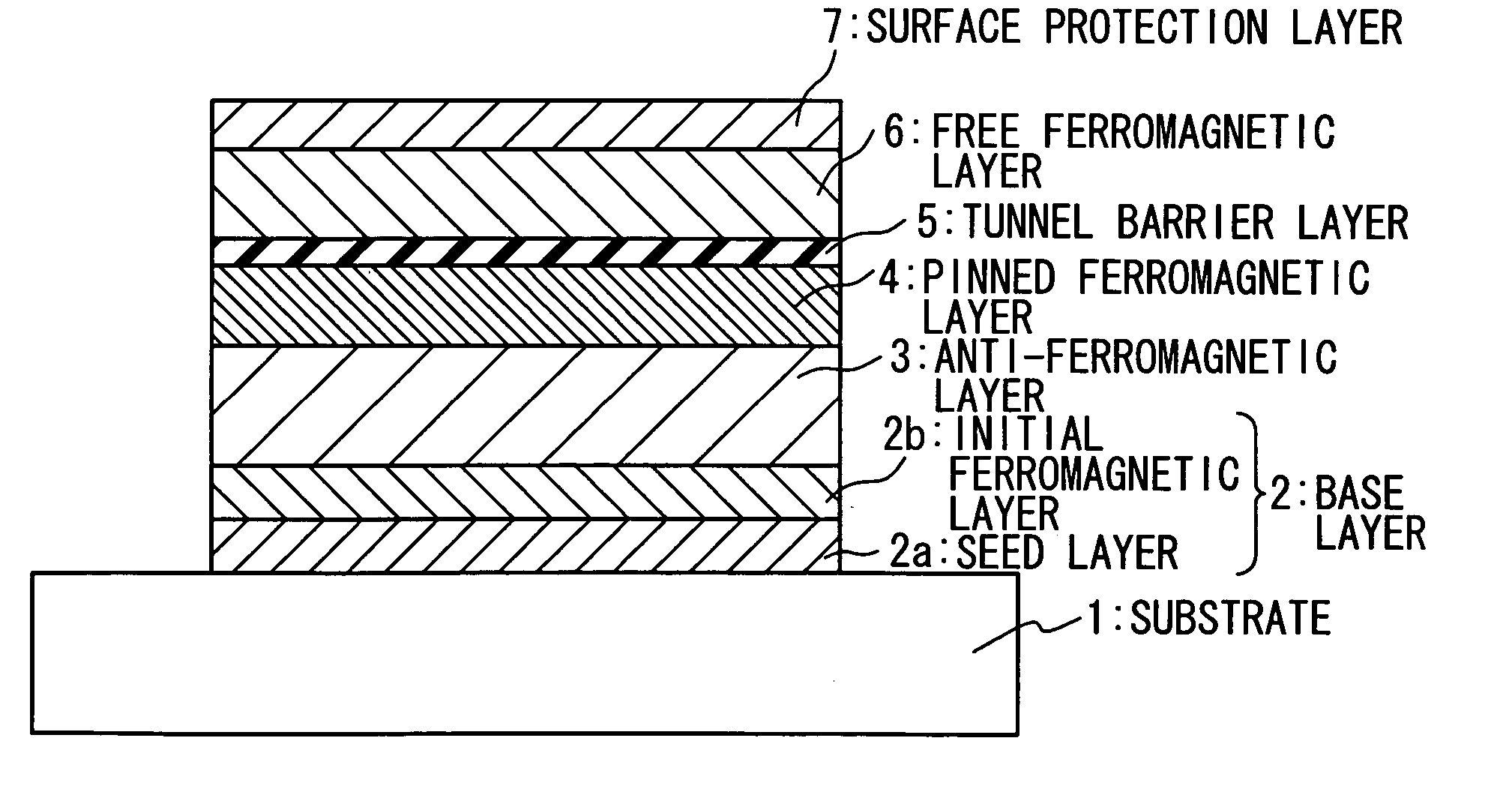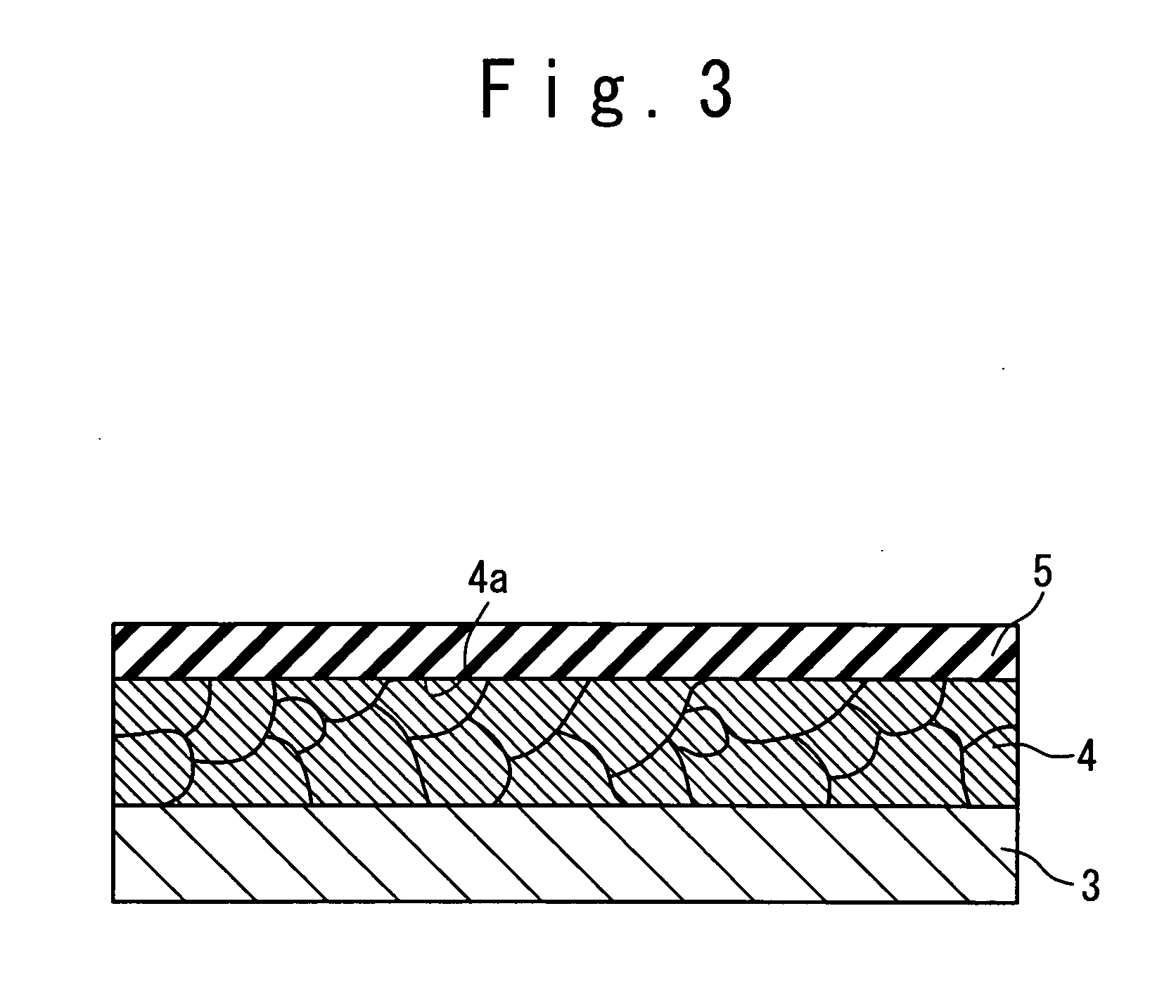Magnetoresistive device and method for manufacturing same
a magnetic resistance and magnetic field technology, applied in the field of magnetic resistance devices, can solve the problems of heat resistance and the magnetic field necessary to reverse the direction of the spontaneous magnetization of the free ferromagnetic layer, and achieve the effect of improving the heat resistance of the magnetic resistance devi
- Summary
- Abstract
- Description
- Claims
- Application Information
AI Technical Summary
Benefits of technology
Problems solved by technology
Method used
Image
Examples
first embodiment
[0041]FIG. 2 shows a magnetic resistance device according to the first embodiment of the present invention. In the magnetic resistance device of the first embodiment, memory cells of a MRAM utilizing the magnetic resistance devices showing TMR effect are provided. The memory cell is composed of a substrate 1 and a base layer 2. The base layer 2 is formed on the substrate 1. The base layer 2 contains a seed layer 2a formed on the substrate 1 and an initial ferromagnetic layer 2b formed on the seed layer 2a. The seed layer 2a is typically formed of tantalum and the initial ferromagnetic layer 2b is formed of Ni—Fe.
[0042] On the base layer 2, an anti-ferromagnetic layer 3 is formed. For example, the anti-ferromagnetic layer 3 is formed of anti-ferromagnetic material such as Ir—Mn and Pt—Mn. On the anti-ferromagnetic layer 3, a pinned ferromagnetic layer 4 is formed. For example, the pinned ferromagnetic layer 4 is formed of ferromagnetic material such as Ni—Fe and Co—Fe. The pinned fe...
experiment examples
[0053] Experiment examples 1 and 2 as the magnetic resistance device according to the present invention were compared with a comparison example 1. In all of the experiment example 1, the experiment example 2 and the comparison example 1, the seed layer 2a was formed as a tantalum layer having the thickness of 3 nm. The initial ferromagnetic layer 2b was formed as a NiFe layer having the thickness of 3 nm, and the anti-ferromagnetic layer 3 was formed as an IrMn layer having the thickness of 10 nm. Also, the pinned ferromagnetic layer 4 was formed as a CoFe layer having the thickness of 10 nm, and the tunnel barrier layer 5 was formed as an AlOx layer having the thickness of 1.5 nm. The free ferromagnetic layer 6 was formed as a NiFe layer having the thickness of 5 nm, and the surface protection layer 7 was formed as a Ta layer having the thickness of 5 nm.
[0054] The magnetic resistance device of the experiment example 1 was formed by the first manufacturing method of the above-ment...
second embodiment
[0063]FIG. 5 shows a magnetic resistance device according to the second embodiment of the present invention. In the second embodiment, diffusion of the material of the anti-ferromagnetic layer 3 into the tunnel barrier layer 5 is prevented by a different method from that of the first embodiment.
[0064] First, in the magnetic resistance device of the second embodiment, the pinned ferromagnetic layer 11, the non-magnetic layer 12 and the second pinned ferromagnetic layer 13 are formed on the anti-ferromagnetic layer 3 in order. The tunnel barrier layer 5 is formed on the second pinned ferromagnetic layer 13. For example, the first pinned ferromagnetic layer 11 is formed of the ferromagnetic material such as Ni—Fe and Co—Fe. The first pinned ferromagnetic layer 11 formed of the ferromagnetic material has the spontaneous magnetization. The direction of the spontaneous magnetization of the first pinned ferromagnetic layer 11 is fixed through the interaction with the anti-ferromagnetic la...
PUM
 Login to View More
Login to View More Abstract
Description
Claims
Application Information
 Login to View More
Login to View More - R&D
- Intellectual Property
- Life Sciences
- Materials
- Tech Scout
- Unparalleled Data Quality
- Higher Quality Content
- 60% Fewer Hallucinations
Browse by: Latest US Patents, China's latest patents, Technical Efficacy Thesaurus, Application Domain, Technology Topic, Popular Technical Reports.
© 2025 PatSnap. All rights reserved.Legal|Privacy policy|Modern Slavery Act Transparency Statement|Sitemap|About US| Contact US: help@patsnap.com



